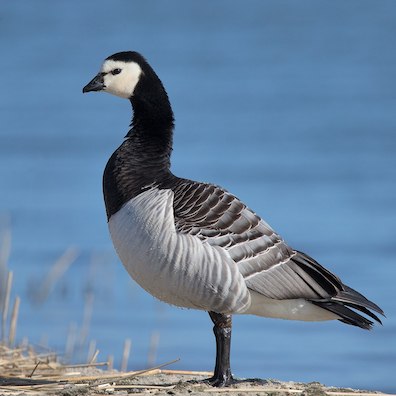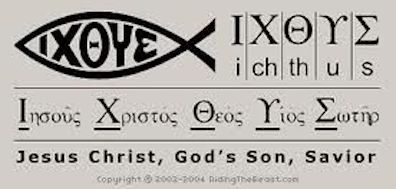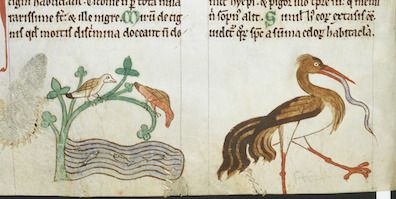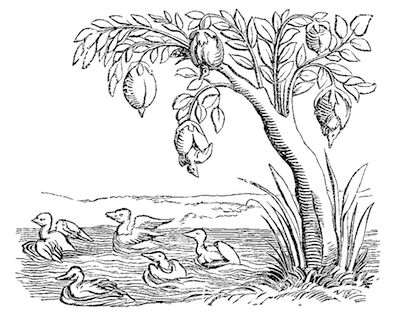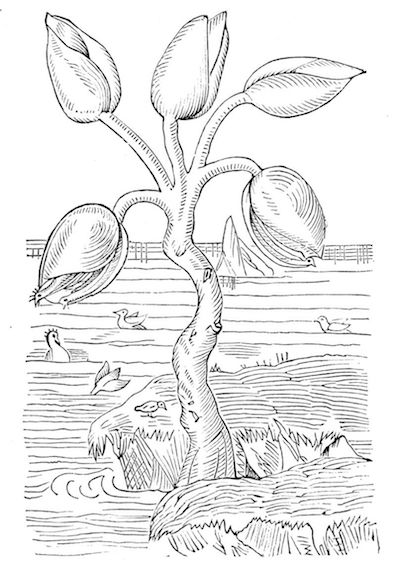The paragraph in which the sentence appears suggests a
bleakly materialistic context for Stephen's thoughts: "Bag
of corpsegas sopping in foul brine. A quiver of minnows, fat
of a spongy titbit, flash through the slits of his buttoned
trouserfly. . . . Dead breaths I living breathe, tread dead
dust, devour a urinous offal from all dead. Hauled stark
over the gunwale he breathes upward the stench of his
green grave, his leprous nosehole snoring to the sun."
Bodies decaying and bloating, infecting and consuming other
bodies, excreting waste until they themselves become waste to
be recycled by other organisms: these thoughts are consistent
with the meditations on mortality that Stephen has conducted
throughout the chapter, looking at broken seashells and dead dogs and recognizing
their kinship with human beings. The animate no less than the
inanimate world is an endless shuffling of essentially "dead"
materials. Everything is in flux; no one survives the process
of endless change. Leopold Bloom will think similar thoughts
in Hades.
But life does persist, and it seems to obey—if only
whimsically, fancifully—laws of metempsychosis
and metamorphosis that Stephen has also been pondering
throughout the chapter. A dog can transform before one's
eyes into a hare, a horse, a deer, a bear, a cow, a wolf, a
leopard, a panther, a vulture; waves appear to be walruses,
serpents, and "the steeds of
Mananaan." Human beings become rabbits or geese or pigeons. People may remember
events from other lives many centuries earlier,
or reincarnate figures like Moses
in the bulrushes, the Israelites
in Babylon, or Lady
Macbeth. All of life seems to be bound together by
principles of interpenetration that call into question the
finality of death.
The Christian theology in which Stephen is steeped enters
into his thinking: in the great mysterious act of Incarnation
that transforms the immortal deity into mortal flesh, "God
becomes man." And then, somewhat more fancifully, "man
becomes fish" because early Christians
anagrammatically associated their Savior with the Greek word
for fish. The letters of Ichthys spell out Christ's
essential names and properties: Iota initiates Iesous,
Jesus; Chi begins Christos, the Messiah or anointed
one; Theta invokes Theos, God; Ypsilon begins Yios,
Son; and Sigma spells Soter, Savior. (It is perhaps
not too ingenious to hear also in this phrase the ritual of
Communion in which God gives himself to man to be eaten, for
when Jesus performed miracles of feeding the hungry he gave
them fish.)
Some geese do eat small fish, but the primary logic for the
next transformation in Stephen's sentence is legendary. The "barnacle
goose," a medium-sized species with distinctive black
and white coloring on its head, got its name from a medieval
theory that these birds do not procreate in the normal way.
According to Gerald of Wales, writing in the Topographia
Hiberniae (1187), barnacle geese "are produced from
fir timber tossed along the sea, and are at first like gum.
Afterwards they hang down by their beaks as if they were a
seaweed attached to the timber, and are surrounded by shells
in order to grow more freely. Having thus in process of time
been clothed with a strong coat of feathers, they either fall
into the water or fly freely away into the air. They derived
their food and growth from the sap of the wood or from the
sea, by a secret and most wonderful process of alimentation. I
have frequently seen, with my own eyes, more than a thousand
of these small bodies of birds, hanging down on the sea-shore
from one piece of timber, enclosed in their shells, and
already formed. They do not breed and lay eggs like other
birds" (quoted from Edward Heron-Allen, Barnacles in
Nature and Myth [1928, rpt. 2003], p. 10).
Fantastical as the ornithology may be, Gerald's description
of the young birds' development does come pretty close to
describing the domestic arrangement of barnacles, which attach
to marine surfaces by their heads ("hang down by their beaks
as if they were a seaweed"), grow thick shells as a protective
home ("surrounded by shells in order to grow more freely"),
and use their long delicate legs to trap food from the
seawater and move it toward their mouths ("clothed with a
strong coat of feathers"). It seems quite likely that Gerald's
theory was based on close empirical observation of barnacles,
but later writers elaborated more inventive accounts, as
illustrated in the 16th century images here.
This medieval association between small sea creatures and a
particular bird explains how "fish becomes barnacle
goose." Stephen might have taken an interest in the
legend not only because it was attached specifically to
Ireland—for several centuries the Topography of Ireland gave
other Europeans most of their information about that
country—but also because churchmen squabbled for several
centuries over whether the barnacle goose's unusual origins
meant that it was really fish rather than flesh and therefore
could be eaten on Fridays. This is the sort of rational
theological absurdity that Stephen simply adores.
But Barnacle was also the surname of the woman whom James
Joyce chose for his spouse: after meeting her, John Joyce ventured his
opinion that "she will stick." This surname cannot be present
in Stephen's consciousness, but he is walking on Sandymount
Strand on 16 June 1904, the very day when Joyce walked out there with Nora
and had a transformative
sexual experience, and several paragraphs earlier he has
been thinking, "Touch me. Soft eyes. Soft soft soft hand. I am
lonely here. O, touch me soon, now," so the reader must
suppose that the author intends to place Nora within his web
of associations. With this added context, "barnacle
goose becomes featherbed mountain" acquires
distinctly erotic overtones. The feathers of dead geese are
used to stuff a featherbed, and Nora too gets into that soft
lovely bed.
All of these fanciful chains of association soften the
brutally reductive vision of devouring a urinous offal from
all dead. Summing them up, one might say that life reigns in
the midst of death. And from this perspective, one can also
note that the corpse on which Stephen is centering his
speculations is not completely dead. The "quiver of
minnows," darting like little arrows and flashing
gleams of silver light, quiver with some of the life of the
penis they have been snacking on. And the man's leprous
nosehole is "snoring." In a strong
anticipation of Finnegans Wake, this corpse may only
be sleeping, and sleeping people merge with features of the
landscape. Like Anna Livia "moananoaning" her "seasilt
saltsick" way to the bay and HCE feeling his "humptyhillhead"
in Howth and his "tumptytumtoes" at their "knock out in the
park," this unconscious man has metamorphosed into the Featherbed Mountain.
